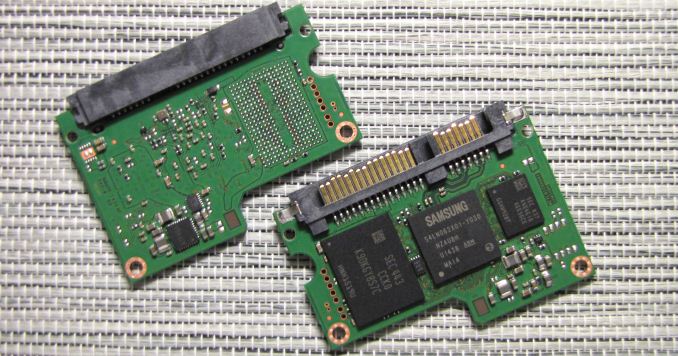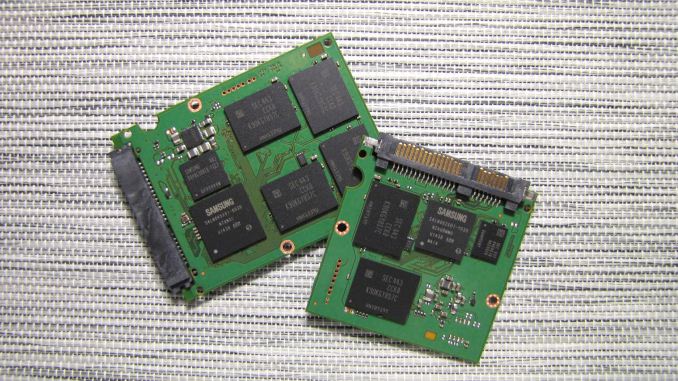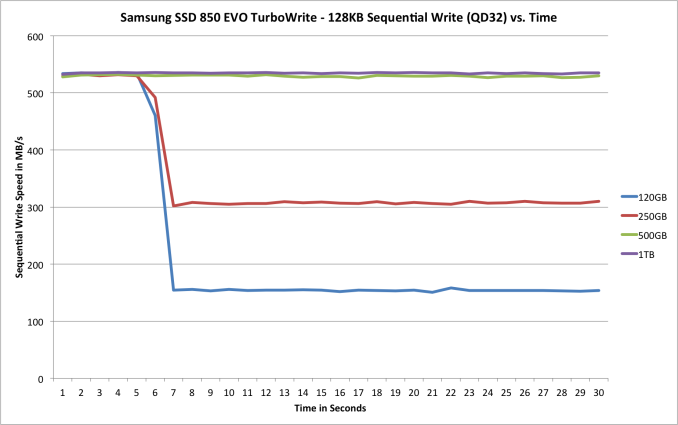Samsung SSD 850 EVO (120GB, 250GB, 500GB & 1TB) Review
by Kristian Vättö on December 8, 2014 10:00 AM ESTInside The Drives
There are three different PCB designs in the 850 EVO lineup. The 120GB and 250GB models (above) use a tiny PCB with room for two NAND packages (one on each side). Interestingly enough, both use octal-die packages, meaning that the 120GB 850 EVO only has a single 128GB (8*16GB) NAND package. Decoding the part number reveals that the packages are equipped with eight chip enablers (CEs), so a single NAND package is viable since all eight dies can be accessed simultaneously.
The use of octal-die packages is actually true for all capacities. It's an interesting choice nevertheless, but I suspect Samsung's packaging technology is advanced and mature enough that it's more cost efficient to use high die count packages and small PCBs instead of larger PCBs with more and less dense NAND packages.
| Samsung SSD 850 EVO NAND Configurations | ||||
| Capacity | 120GB | 250GB | 500GB | 1TB |
| # of NAND Packages | 1 | 2 | 4 | 8 |
| # of Die Per Package | 8 | 8 | 8 | 8 |
| Total # of Die | 8 | 16 | 32 | 64 |
| Die Capacity | 128Gbit | 128Gbit | 128Gbit | 128Gbit |
| Raw NAND Capacity | 128GiB | 256GiB | 512GiB | 1024GiB |
| Over-Provisioning | 12.7% | 9.1% | 9.1% | 9.1% |
TurboWrite
TurboWrite is a feature that Samsung brought to the 840 EVO to increase write performance. The idea of running a small portion of the NAND in SLC mode was nothing new, but it was the first time it truly made sense because the 840 EVO used slower TLC NAND and hence the SLC buffer could provide significant improvements to write performance and user experience. Unsurprisingly, TurboWrite is also present in the 850 EVO.
| Samsung SSD 850 EVO TurboWrite SLC Buffer Size | ||||
| Capacity | 120GB | 250GB | 500GB | 1TB |
| TurboWrite Buffer Size | 3GB | 3GB | 6GB | 12GB |
The buffer sizes and core architecture have remained unchanged. All writes hit the SLC buffer first, from which they then get moved to the TLC array during idle time. The only exception is a case of long, sustained period of writes that exceeds the buffer size, in which case the data will be written straight to the TLC portion.
| Write Performance With and Without TurboWrite | ||||
| With TurboWrite | Without TurboWrite | |||
| Sequential Write | 4KB Random Write (QD32) | Sequential Write | 4KB Random Write (QD32) | |
| 120GB | 520MB/s | 88K IOPS | 150MB/s | 38K IOPS |
| 250GB | 520MB/s | 88K IOPS | 300MB/s | 70K IOPS |
| 500GB | 520MB/s | 90K IOPS | 500MB/s | 80K IOPS |
| 1TB | 520MB/s | 90K IOPS | 520MB/s | 80K IOPS |
Samsung's reviewer's guide states that the 850 EVO features "enhanced TurboWrite technology" with a focus on random write performance, but I don't have any additional details as to how the TurboWrite implementation in the 850 EVO differs from the 840 EVO. TurboWrite was always designed to cache all writes regardless of the nature of the write (random vs sequential), so I'm not sure if anything has actually changed. Obviously the algorithms have been optimized for the new NAND and controller architecture and it's possible that the whole batch of algorithms has improved in the process, but I'll provide an update when I hear back from Samsung.
I ran a quick sequential write test to see how TurboWrite behaves in the 850 EVO. At smaller capacities it clearly provides a tremendous performance boost, but at 500GB and 1TB there is enough NAND to provide the parallelism that is needed to max out the SATA 6Gbps interface. That is a big improvement over the 840 EVO as its write performance maxed out at ~400MB/s when writing to the TLC array, so the performance benefits of 3D NAND technology are already evident.













97 Comments
View All Comments
R3MF - Tuesday, December 9, 2014 - link
my mistake, i had presumed that the Pro was not a consumer part.still, six months on with the arrival of tons of X99 and Z97 boards sporting m.2 slots, and the drives based on the marvell controller just months away, i'd have thought it would merit a mention.
hojnikb - Tuesday, December 9, 2014 - link
There is a separate article adressing this....cm2187 - Tuesday, December 9, 2014 - link
But out of curiosity, what are you going to do with the extra performance? Who actually has any use specs higher than what the EVO already offers. It is certainly the case on some heavy load server but for end users, even enthusiasts like me, I am not sure I would get an even slightly better experience by beating the SATA 3 specs.R3MF - Tuesday, December 9, 2014 - link
I presume that SATA express and m.2 were invented for no reason then?Bandwidth is useful, as is lower latency.
cm2187 - Wednesday, December 10, 2014 - link
Well, it's not because it is invented that it is useful. It's like having dozen of cores in a CPU. Some applications will have some use for these cores (certainly relevant on servers or for virtualization). But the vast majority of common applications are single threaded so people should rather focus on higher clock rates. I'm always happy to see higher specs but I just wonder which of my application will be faster with M2.Supercell99 - Sunday, December 14, 2014 - link
Virtualization. I run VMware with several OS's running at the same time on my desktop. Being able to startup and have these run off a low latency disk is nice. Power users always have a need for high bandwidth, low latency I/O.hojnikb - Wednesday, December 10, 2014 - link
These can be used for PCI-E or SATA protoco. In fact, most m.2 drives run sata instead of pci-edcaxax - Tuesday, December 9, 2014 - link
I'm unconvinced by Samsung. My SSD 830 is doing ok, having suffered an acceptable 30% performance decline (which may be correctable via secure erase but I will not test this).But my 840 (non-EVO) which works in my HTPC and sees limited use outside of the hibernation file (60 of the drive is empty by the way) is now running more than 60-70% slower.
This is just unacceptable in a system which supports trim (win 7 x64). Samsung have done nothing to rectify this, claiming these problems occur on their EVO line. Until they change their approach, I'm inclined to distrust their latest cost-saving "innovation" and give my money to crucial instead.
simonpschmitt - Tuesday, December 9, 2014 - link
Dear Mr. Vättö,while I don't think it would necessary belong into this article R3MF has a point. What is the state of SATAExpress, NGFF, m.2, ... currently? My laptop is 18 Month old and has an unuses m.2-slot witch, to my knowledge, nobody ever put an SSD into. You seem to have an ear to the ground when it comes to the SSD-Industry. There are a few questions you might have a qualified opinion about:
- Will we be seeing current-gen (meaning 850 EVO-gen) m.2/SATAExpress SSDs?
- If yes, up to wich capacity in wich form factor (2242, 2280, ...)?
- with regards to m.2: Will there be mainly PCIe (2 lanes/4lanes) drives or SATA?
- When do you suppose these will be an economically viable alternative to 2.5" given both slots are available?
In your personal opinion:
- What is the point of SATAExpress when literally every SATAExpress-Device also has m.2?
- Will there be a subjective improvement for the normal or enthusiast (non Datacenter) user with the switch to PCIe?
A quick blurb, perhaps in the form of a short pipeline aticle, would be much appreciated.
An other thing I always wondered about: While I am amazed with the percieved benefits of an SSD vs. an HDD game-load-times often seem not to change at all. It's more of an oddity than a real concern but my new system (i5 4200, 8GB, 840 EVO) often has the same load times than my old system (i3 330, 4GB, HDD). I always thought load times were mainly dependent on how fast the data can be read (HDD/SDD bound) and how fast it can be processed/extracted (CPU bound). Is there a factor I'm missing or do games just not take advantage of certain kinds of faster hardware.
Perhaps you or some of the other readers can help me with my curiosity.
Thanks, Simon
metayoshi - Tuesday, December 9, 2014 - link
I can't answer all of your questions, but I can answer the gaming part.With regards to gaming, it really depends on the game. Many games these days are relatively optimized on loading, so running them on an HDD or SSD doesn't matter too much since they like to load parts of the game in the background. However, there are some games where having an SSD is completely noticeable. As an avid World of Warcraft player, I can tell which raid members have SSDs and which don't because those of us with SSDs simply appear in the raid much faster than those on HDDs when switching zones. I mean, it definitely doesn't hinder gameplay too much since the only thing that takes a while is actually getting into the zone. The rest of the zone is in RAM already, so getting to and fighting bosses are instantaneous. I used to have a 7200 RPM drive before too. For me, the difference is completely noticeable now that I have had an SSD for a couple of years now.